Stephen L. Herman, Bennie Sparkman. Electricity and Controls for HVAC-R (6th edition)
Подождите немного. Документ загружается.

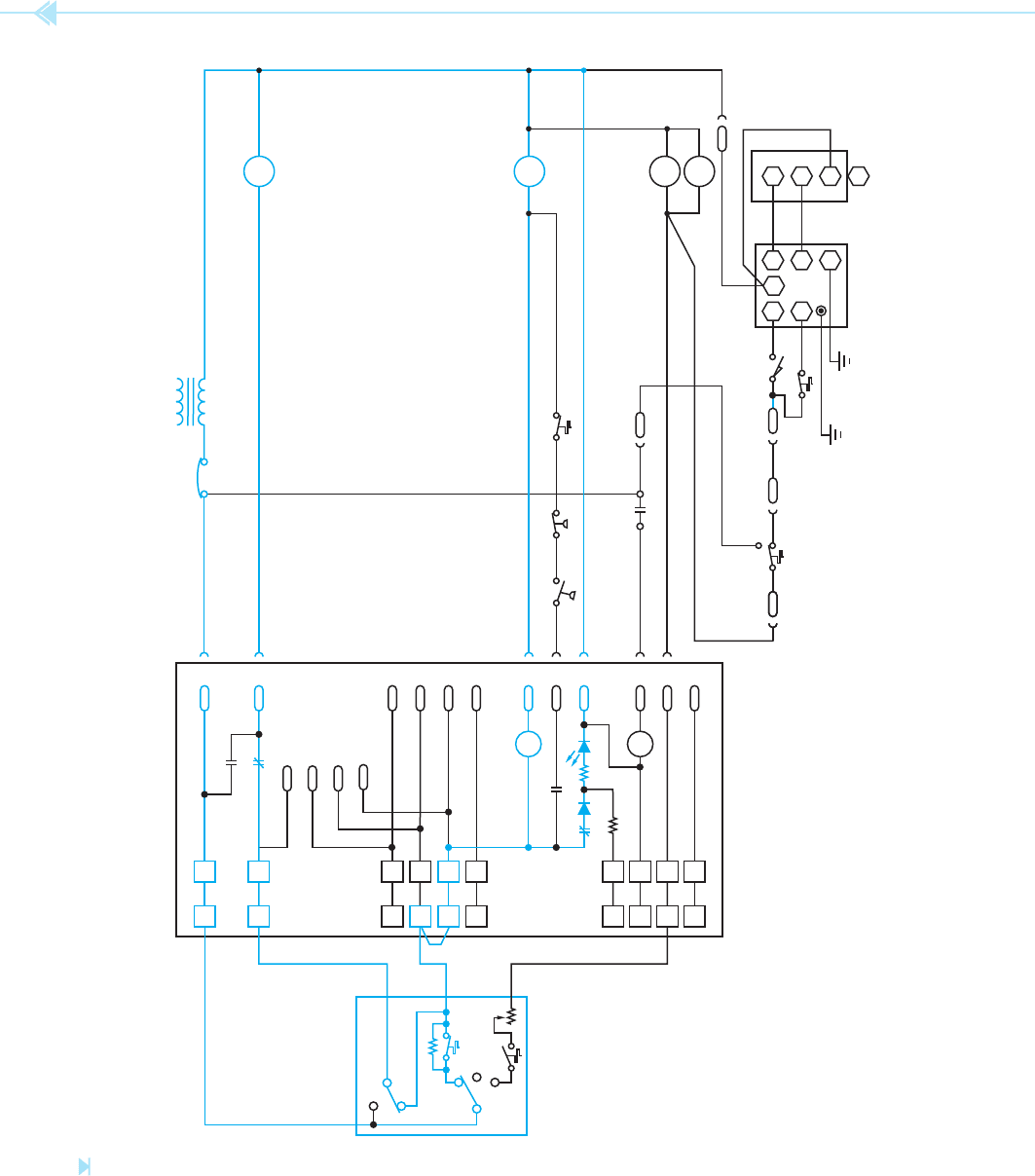
410 SECTION 6 Troubleshooting Using Control Schematics
Figure 44–10
The lock-out relay has energized. (Source: Delmar/Cengage Learning)
2M
1M
TDR
DMR
TEHPLP
S4TDR
S4S4 P4 S3
LS1
CS
LS2
TH PV
GND
R1
MV
IC
4
TH/R
TH
TR
GNC
GV
SENSOR
SPARK
1M COMPRESSOR CONTACTOR
2M EVAPORATOR FAN CONTACTOR
CB CIRCUIT BREAKER
CLI COMPRESSOR LOCK-OUT INDICATOR
CS CENTRIFUGAL SWITCH
DMR DRAFT MOTOR RELAY
GV GAS VALVE
HP HIGH-PRESSURE CONTROL
IC IGNITION CONTROL
K1 COMPRESSOR LOCK-OUT RELAY
K3 BLOWER INTERLOCK RELAY
LP LOW-PRESSURE CONTROL
LS1 LIMIT SWITCH
LS2 LIMIT SWITCH
TE LOW EVAP. TEMP. THERMOSTAT
TH THERMOSTAT, H E ATING
TDR TIME DELAY RELAY
CB
S1
K3
B
7
X 11
5
S1
W1
2
13
S1
W2 5
10
S1
Y2
10
3
S1
Z 1
14
S1
N 4
12
S1
Y1 8
4
S1
K1
1
S1
2
S1
7
S1
6
S1
R 6
9
S6
S8
S8
S8
K1 CL1
K1
K3
K3
FAN ON
FAN AUTO
OFF
THERMOSTAT
COOL
HEAT
G 9

UNIT 44 Packaged Units: Electric Air Conditioning and Gas Heating 411
SUMMARY
The schematic diagram in this example shows mostly the operation of the heating system.
The thermostat in this diagram has four terminals labeled R, G, Y, and C.
The thermostat is connected to the 24-volt side of the transformer.
The heating system contains two high-limit switches.
Both of the high-limit switches are connected normally closed and are connected in series
with the automatic gas valve.
KEY TERMS
auxiliary limit door interlock main limit
condensing unit lock-out relay
REVIEW QUESTIONS
Refer to the schematic shown in Figure 44–1 for the following questions.
1. The unit will operate normally in the cooling cycle. When the unit is switched to the
heating cycle, the gas burner will not ignite. List four possible problems.
2. The blower fan will operate normally in the cooling cycle. In the heating cycle, how-
ever, the fan will not operate. List three possible problems.
3. The unit will not operate in the heating or cooling cycle. A voltage check shows that
there is no low voltage for operation of the control circuit. List three possible problems.
4. A lock-out protection circuit involves connecting the coil of the lock-out relay in
series with the coil of the compressor contactor. When this circuit is energized, why is
most of the voltage across the lock-out relay coil and very little across the compressor
contactor coil?
5. Once the lock-out relay has been energized, what must be done to reset the circuit?
TROUBLESHOOTING QUESTIONS
Refer to the schematic shown in Figure 44–1 to answer the following questions. Note that this draw-
ing is a combination of both a schematic and a wiring diagram. Also note that most of the control
shown is of the heating system. The air conditioning part of this unit is referred to as “condensing
unit” on the diagram. The thermostat contact arrangement is not shown in this diagram, but recall
that in the cooling mode, terminals G and Y make connection with terminal R when the thermostat
contact closes. In the heating mode, terminal R makes connection with terminal W when the thermo-
stat contact closes.

412 SECTION 6 Troubleshooting Using Control Schematics
1. When the unit is in the heating mode, what controls the operation of the blower motor?
A. Thermostat
B. Fan relay
C. Fan switch
D. Main limit switch
2. When the unit is used in the heating mode, which blower fan speed is used?
A. HIGH
B. MED
C. LOW
3. Assume that when in the heating mode, the gas burner will start when the thermostat
calls for heat, but the blower motor will not run and eventually the burner is turned off by
the main limit switch. Now assume that when the fan switch on the thermostat is moved
to the manual position, the blower motor begins operating. List three conditions that
could cause this problem.
A. _____________________________________________________________________
B. _____________________________________________________________________
C. _____________________________________________________________________
4. When the unit is in the cooling mode, which thermostat terminal controls the operation
of the blower motor?
A. R
B. W
C. Y
D. G
5. Describe the operation of the door interlock switch.
A. The door interlock switch will prevent the unit from operating in either the heating or
cooling mode. If the unit is in operation and the door is opened, the unit will stop opera-
tion. If the unit is not operating it cannot start in either the heating or cooling mode.
B. The door interlock switch will prevent operation in the heating mode only.
C. The door interlock switch will prevent operation in the cooling mode only.
D. The door interlock switch will prevent the unit from starting in either the heating or
cooling mode, but if the unit is in operation when the door is opened, it will continue to
operate until the thermostat is satis ed.
To answer the following questions, refer to the schematic diagram in gure 44–6.
6. Assume that the thermostat is set in the heating mode and that the heating thermostat
contact closes. Now assume that the DMR relay coil is defective. Will the gas burner oper-
ate? Explain your answer.
7. Which relay controls the operation of the 2M contactor when the unit is in the heating mode?
8. Is the CLI indicator a __________?
A. Incandescent lamp.
B. Neon lamp.
C. Light-emitting diode.
D. The print does not indicate the type of light producing device.
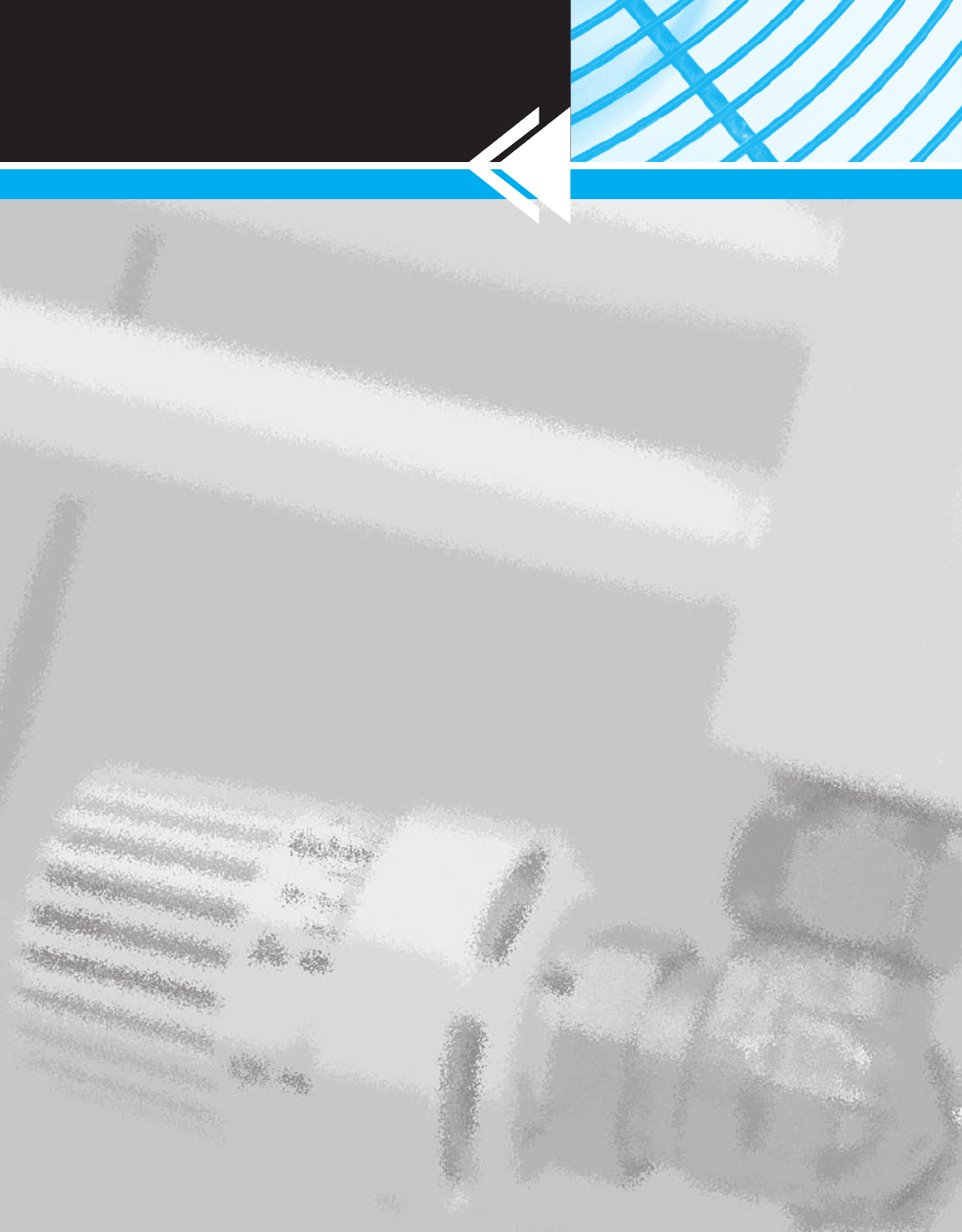
SECTION 7
Ice Maker and
Refrigeration
Controls

414
Ice makers can be divided into two major categories,
household and commercial. Unlike commercial units,
household ice makers do not recirculate water. They
ll a tray or mold and the water is allowed to freeze.
Various methods are used to sense when the water
has been frozen and to eject the ice from the tray.
Commercial ice makers generally recirculate the
water during the freeze cycle. The one reason for
this is that pure water freezes faster than water
containing impurities and minerals. The ice formed
is more pure and clearer in color. This does not
apply to aker-type machines, however. Flaker or
crushed-ice machines use an auger to scrape ice off
an evaporator after the water has been frozen.
Some cube-type machines freeze water in the
shape of the cube, and others freeze water as a slab.
The slab-type machines use a grid of cutter wires to
cut the frozen slab into cubes.
OBJECTIVES
After studying this unit the student should
be able to:
Discuss the operation of a compact-
type ice maker
Describe the operation of the water
valve and fl ow washer
Discuss the sequence of events that
takes place during each stage of the
ice maker’s operation
Discuss the operation of a fl ex tray
ice maker
Household Ice
Makers
UNIT 45
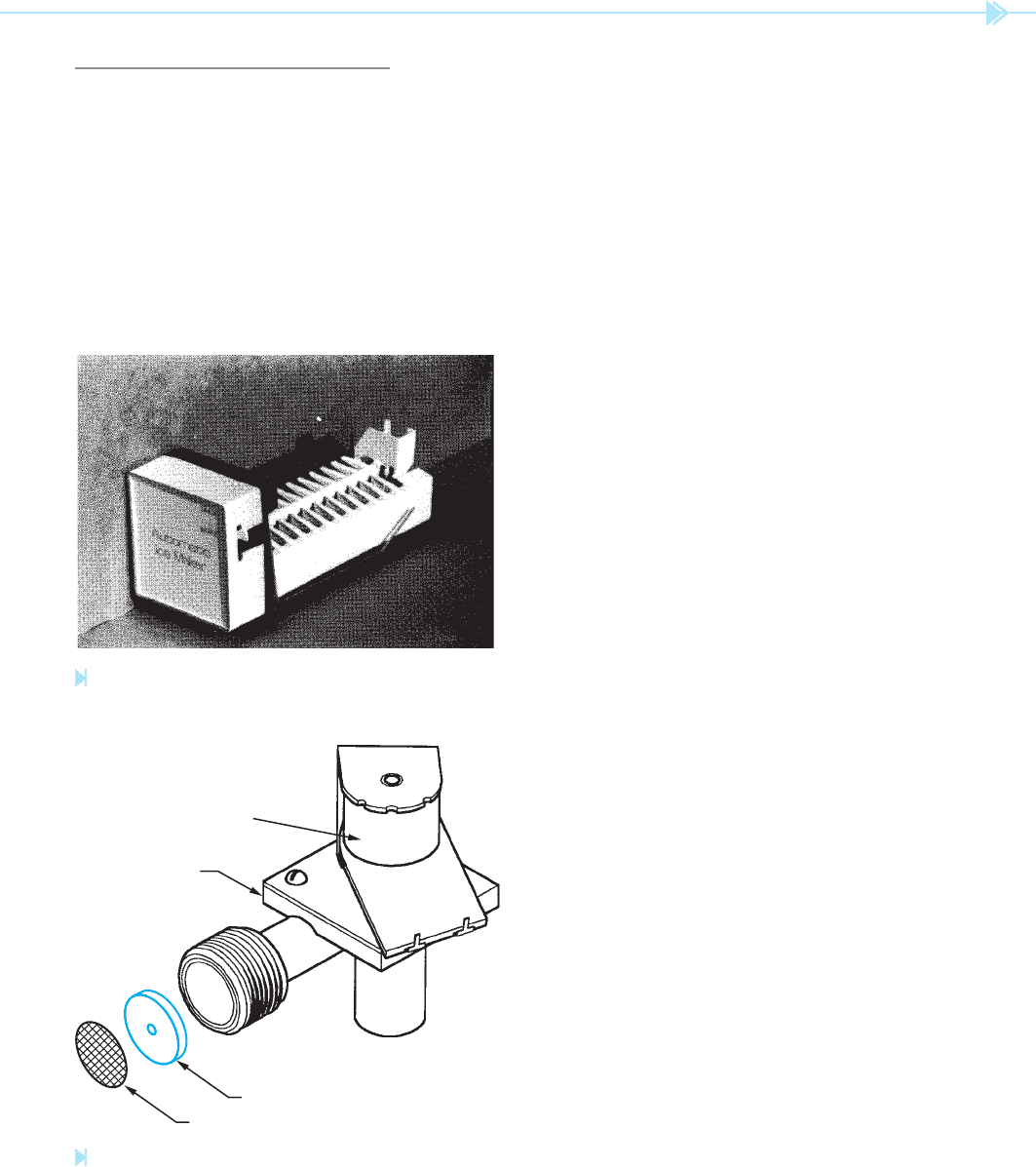
UNIT 45 Household Ice Makers 415
HOUSEHOLD ICE MAKERS
One of the most widely used household ice makers
is the compact, Figure 45–1. Although a newer
model has been introduced, many of these original
units are still in operation. The basic operation of
this unit is as follows:
1. An electric solenoid valve, Figure 45–2, turns
on and lls the tray or mold with water. The
valve contains a ow washer that meters
the amount of water. The washer is designed
to work with pressures that range between
15 and 100 psi. The length of time the water
is permitted to ow is controlled by a cam
operated by a small electric motor. The time
can be adjusted by moving the water sole-
noid switch closer to or farther away from
the cam. The amount of water needed to ll
the mold is approximately 135 cc or 4 oz. It
should be noted that insuf cient water causes
the thermostat to cool too quickly, causing
the ice maker to eject hollow cubes.
2. A thermostat senses when the water is
frozen. It is mounted directly on the mold by
a spring clip. The thermostat controls the
start of the ejection and re ll cycle.
3. When the thermostat contact closes, it turns
on the mold heater and motor. The motor
operates the timing cam and ejector blades.
The ice maker is so designed that the ejec-
tor blades can stall against the ice cubes
without causing harm to the motor or me-
chanical parts. When the heater has warmed
the mold suf
ciently, the ice cubes are pushed
out by the ejector blades.
4. During the ejection cycle, the shutoff arm
rises and lowers. The shutoff arm senses the
height of ice in the holding bin. If the bin is
not full, the arm returns to its original posi-
tion and the ice maker is permitted to eject
ice cubes again after they have been frozen. If
the holding bin is full, however, the arm can-
not return to its normal position and the next
ejection cycle cannot begin. The ice maker
can be manually turned off by raising the
shutoff arm above its normal range of travel.
The ice maker will normally permit the ejector
blades to make two revolutions before the thermo-
stat reopens its contact and permits the process
to stop at the end of the cycle. If the ejector blades
make only one revolution, the ice cubes will be left
on top of the blades instead of being dumped into
the holding bin. This is not a problem, however,
because the cubes will be dumped at the beginning
of the next ejection cycle. Near the end of the cycle
the mold is re lled with water.
FLOW WASHER
STRAINER
VALVE BODY
SOLENOID COIL
Figure 45–1
Early model of a compact ice maker. (Source: Delmar/
Cengage Learning)
Figure 45–2
Water valve. (Source: Delmar/Cengage Learning)
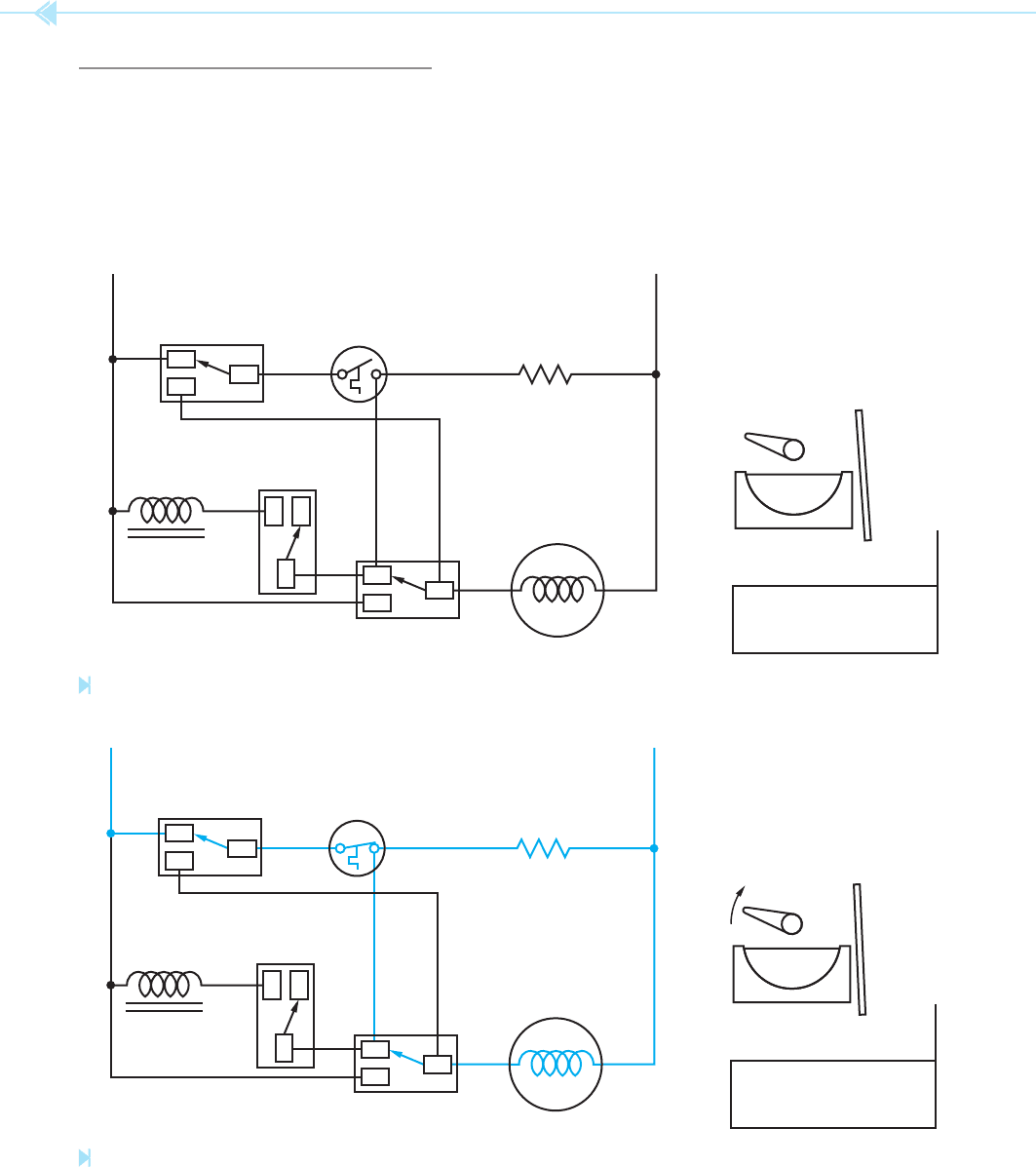
416 SECTION 7 Ice Maker and Refrigeration Controls
OPERATION OF THE CIRCUIT
The basic circuit for the compact ice maker is shown
in Figure 45–3. The circuit is shown during the
freeze cycle. It is assumed that the mold has been
lled with water and the thermostat contact is open.
The shutoff arm is in its normal position, indicating
that the holding bin is not full. Note the position of
the ejector blade and the shutoff arm.
Figure 45–4 shows the circuit at the beginning of
the ejection cycle. At this time, the thermostat has
cooled suf ciently for its contact to close. A current
path now exists through the mold heater and motor,
and the ejector blades begin to turn.
NO
NC
C
NONC
NO
C
NONC
NO
C
WATER
SOLENOID
VALVE
WATER
SOLENOID
SWITCH
HOLDING SWITCH
SHUTOFF SWITCH
THERMOSTAT
117 VOLTS
60 Hz
MOLD HEATER
MOTOR
EJECTOR
BLADE
ICE
STORAGE BIN
SHUT-
OFF
ARM
NO
NONC
NO
NONC
NO
C
WATER
SOLENOID
VALVE
WATER
SOLENOID
SWITCH
HOLDING SWITCH
SHUTOFF SWITCH
THERMOSTAT
117 VOLTS
60 Hz
MOLD HEATER
MOTOR
ICE
STORAGE BIN
SHUT-
OFF
ARM
C
NC
C
Figure 45–3
Basic circuit for the compact ice maker. (Source: Delmar/Cengage Learning)
Figure 45–4
Beginning of the ejection cycle.
(Source: Delmar/Cengage Learning)
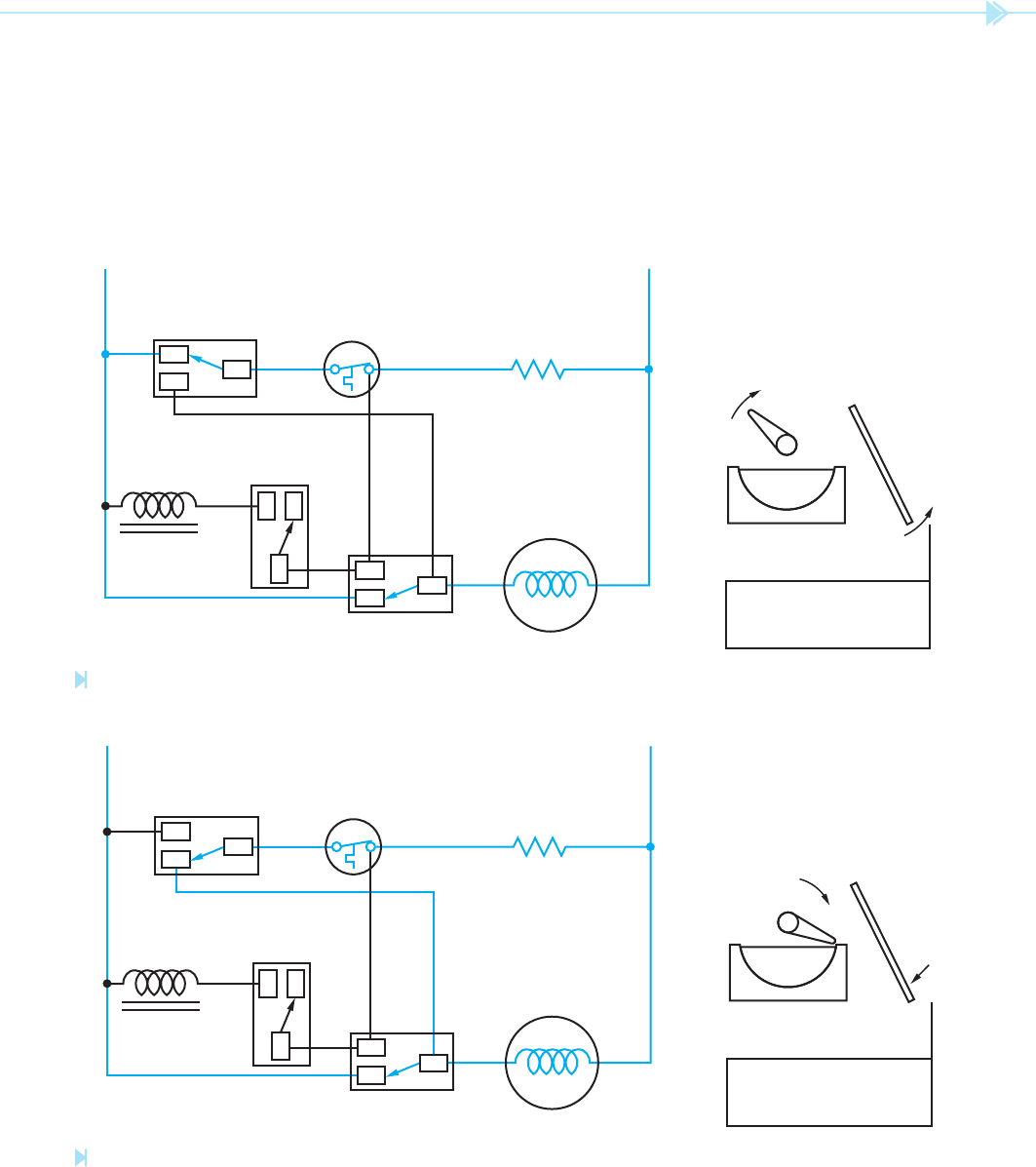
UNIT 45 Household Ice Makers 417
As the motor turns the ejector blades and timing
cam, the holding switch changes position and
the shutoff arm begins to rise, Figure 45–5. The
function of the holding switch is to maintain the
circuit until the cam returns to the freeze, or off,
position.
NO
NONC
NO
NO
NC
NO
C
WATER
SOLENOID
VALVE
WATER
SOLENOID
SWITCH
HOLDING SWITCH
SHUTOFF SWITCH
THERMOSTAT
117 VOLTS
60 Hz
MOLD HEATER
MOTOR
ICE
STORAGE BIN
SHUT-
OFF
ARM
C
NC
C
NO
NONC
NO
NONC
NO
C
WATER
SOLENOID
VALVE
WATER
SOLENOID
SWITCH
HOLDING SWITCH
SHUTOFF SWITCH
THERMOSTAT
117 VOLTS
60 Hz
MOLD HEATER
MOTOR
ICE
STORAGE BIN
SHUT-
OFF
ARM
C
NC
C
In Figure 45–6, the timing cam causes the shut-
off arm to rise and fall, making the shutoff switch
change position. When the ejector blades reach
the ice in the mold, the motor will stall until the ice
cubes are thawed loose by the mold heater. Notice
that the circuit to both the heater and motor has
Figure 45–6
The shutoff switch changes position. (Source: Delmar/Cengage Learning)
Figure 45–5
The shutoff arm begins to rise. (Source: Delmar/Cengage Learning)

418 SECTION 7 Ice Maker and Refrigeration Controls
been maintained by the holding switch. Note that it
is possible for the thermostat to open its contact at
any point in this process. If this should occur, power
is turned off to the mold heater but maintained to
the motor by the holding switch.
Near the completion of the rst revolution of
the ejector blades, the timing cam closes the water
solenoid switch, Figure 45–7. Although the water
solenoid switch is now closed, current cannot ow
through the coil. As long as the thermostat contact
is closed, the same voltage potential is applied to
both sides of the water solenoid coil. Because there
is no potential difference across the coil, no current
can ow and the water valve does not open to per-
mit water ow into the mold.
At the end of the rst revolution, Figure 45–8,
the shutoff arm and ejector blades have returned to
their normal position and the timing cam has reset
NO
NONC
NO
NONC
NO
C
WATER
SOLENOID
VALVE
WATER
SOLENOID
SWITCH
HOLDING SWITCH
SHUTOFF SWITCH
THERMOSTAT
117 VOLTS
60 Hz
MOLD HEATER
MOTOR
ICE
STORAGE BIN
SHUT-
OFF
ARM
C
NC
C
Figure 45–7
The timing cam closes the water solenoid switch. (Source: Delmar/Cengage Learning)
NO
NONC
NO
NONC
NO
C
WATER
SOLENOID
VALVE
WATER
SOLENOID
SWITCH
HOLDING SWITCH
SHUTOFF SWITCH
THERMOSTAT
117 VOLTS
60 Hz
MOLD HEATER
MOTOR
ICE
STORAGE BIN
SHUT-
OFF
ARM
C
NC
C
Figure 45–8
End of the fi rst revolution. (Source: Delmar/Cengage Learning)
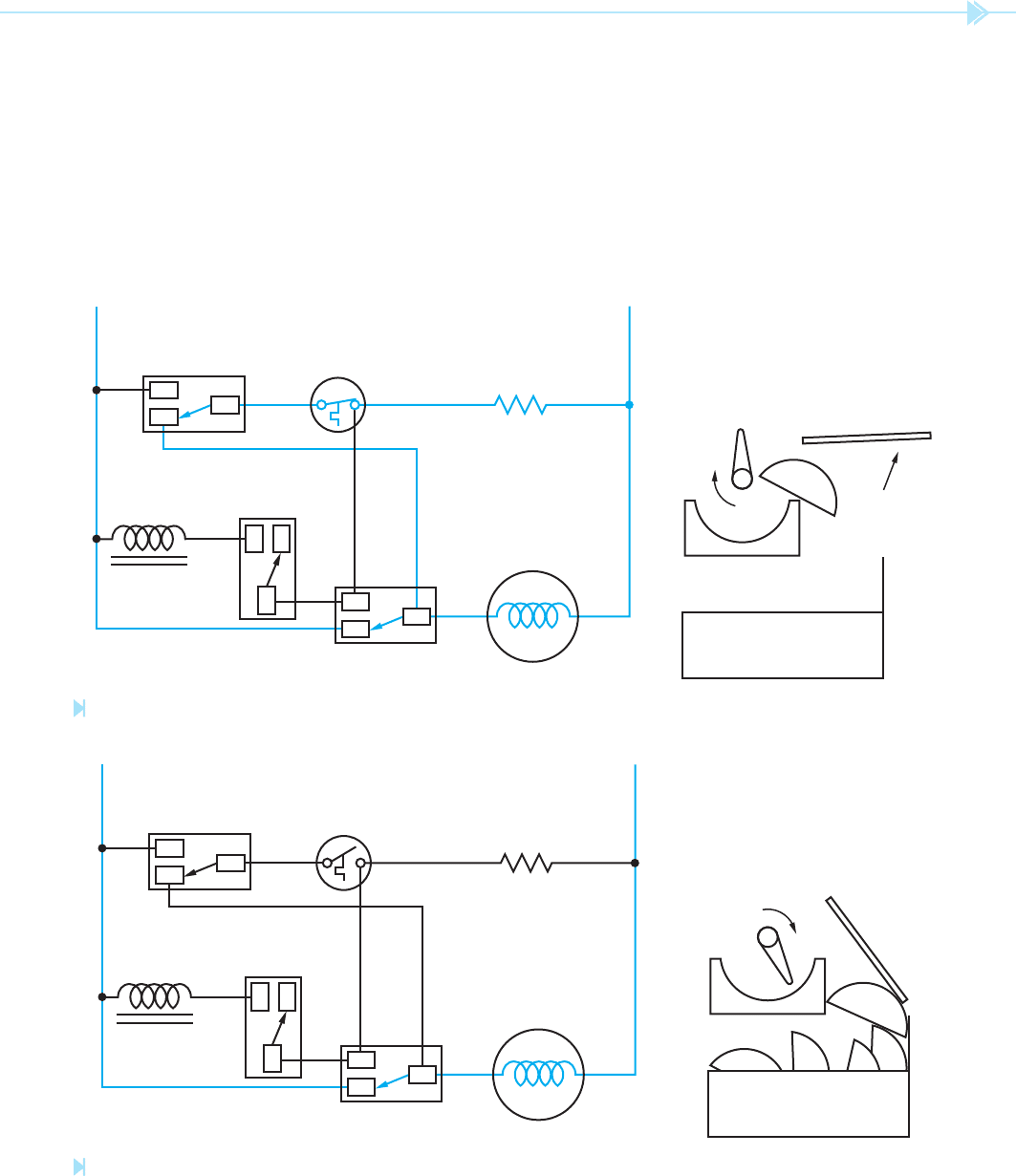
UNIT 45 Household Ice Makers 419
all cam-operated switches back to their normal posi-
tion. Notice, however, that the thermostat contact
has remained in the closed position, permitting the
second revolution to begin.
After the timing cam has rotated a few degrees,
the holding switch again closes to maintain
a current path to the motor and mold heater,
Figure 45–9. The shutoff arm raises and changes
the position of the shutoff switch. The continued
rotation of the ejector blades dumps the ice into the
holding bin.
During the second revolution, the increased tem-
perature from the mold heater causes the thermo-
stat contact to reopen, which deenergizes the heater,
Figure 45–10. The holding contact, however, provides
a continued current path to the motor. If the storage
bin is full, the shutoff arm will not return to its normal
position and the shutoff switch will not be reset.
NO
NONC
NO
NONC
NO
C
WATER
SOLENOID
VALVE
WATER
SOLENOID
SWITCH
HOLDING SWITCH
SHUTOFF SWITCH
THERMOSTAT
117 VOLTS
60 Hz
MOLD HEATER
MOTOR
ICE
STORAGE BIN
SHUT-
OFF
ARM
C
NC
C
NO
NONC
NO
NONC
NO
C
WATER
SOLENOID
VALVE
WATER
SOLENOID
SWITCH
HOLDING SWITCH
SHUTOFF SWITCH
THERMOSTAT
117 VOLTS
60 Hz
MOLD HEATER
MOTOR
SHUT-
OFF
ARM
C
NC
C
STORAGE BIN
Figure 45–10
Middle of the second revolution. (Source: Delmar/Cengage Learning)
Figure 45–9
Beginning of the second revolution. (Source: Delmar/Cengage Learning)
